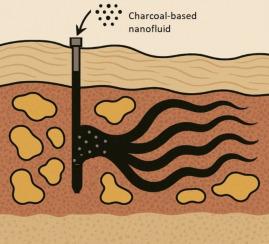Characterisation and application of charcoal-based nanofluids in enhanced oil recovery (EOR)
IF 5.2
2区 化学
Q2 CHEMISTRY, PHYSICAL
引用次数: 0
Abstract
This study investigates charcoal-based nanofluids for enhanced oil recovery (EOR), as a new route of carbon capture, utilisation and sequestration, contributing to alleviating global warming. Previous studies have shown that the microporous structure of nanoparticles enhance the viscosity of a base fluid better than the counterpart of non-porous ones. A pinewood char with a specific surface area of 107 m2/g was selected to examine its viscosity enhancement in aqueous suspension and its EOR performance. Pinewood char nanofluids at a nanoparticle size of approximately 155 nm demonstrated a linear viscosity enhancement with charcoal concentration in the range suitable as flooding fluid. Sectional enhanced nanofluid flooding (0.2 pore volume of the core) into sand-packed cores demonstrated that a 0.125 wt% pinewood char nanofluid (viscosity 2.3 mPa∙s) achieved 51.4 % recovery of the residue oil in place. The nanofluids demonstrated excellent stability under ambient conditions. These findings highlight the feasibility of using charcoal-based nanofluids as a low-cost, renewable and carbon-negative EOR flooding fluids, offering a possible pathway towards more responsible hydrocarbon production that balances technical performance and environmental impact.

碳基纳米流体的表征及其在提高采收率中的应用
本研究探讨了用于提高采收率(EOR)的碳基纳米流体作为碳捕获、利用和封存的新途径,为缓解全球变暖做出贡献。先前的研究表明,纳米颗粒的微孔结构比非孔结构更能提高基液的粘度。选择比表面积为107 m2/g的松木炭,考察其在水悬浮液中的粘度增强和提高采收率的性能。纳米颗粒尺寸约为155 nm的松木炭纳米流体显示出线性粘度增强,木炭浓度在适合作为驱油流体的范围内。分段强化纳米流体驱油(岩心孔隙体积为0.2)到砂填岩心中,结果表明,0.125 wt%的松木炭纳米流体(粘度为2.3 mPa∙s)可实现51.4%的剩余油采收率。纳米流体在环境条件下表现出优异的稳定性。这些发现强调了使用碳基纳米流体作为低成本、可再生和负碳的EOR驱油流体的可行性,为更负责任的油气生产提供了一条可能的途径,可以平衡技术性能和环境影响。
本文章由计算机程序翻译,如有差异,请以英文原文为准。
求助全文
约1分钟内获得全文
求助全文
来源期刊

Journal of Molecular Liquids
化学-物理:原子、分子和化学物理
CiteScore
10.30
自引率
16.70%
发文量
2597
审稿时长
78 days
期刊介绍:
The journal includes papers in the following areas:
– Simple organic liquids and mixtures
– Ionic liquids
– Surfactant solutions (including micelles and vesicles) and liquid interfaces
– Colloidal solutions and nanoparticles
– Thermotropic and lyotropic liquid crystals
– Ferrofluids
– Water, aqueous solutions and other hydrogen-bonded liquids
– Lubricants, polymer solutions and melts
– Molten metals and salts
– Phase transitions and critical phenomena in liquids and confined fluids
– Self assembly in complex liquids.– Biomolecules in solution
The emphasis is on the molecular (or microscopic) understanding of particular liquids or liquid systems, especially concerning structure, dynamics and intermolecular forces. The experimental techniques used may include:
– Conventional spectroscopy (mid-IR and far-IR, Raman, NMR, etc.)
– Non-linear optics and time resolved spectroscopy (psec, fsec, asec, ISRS, etc.)
– Light scattering (Rayleigh, Brillouin, PCS, etc.)
– Dielectric relaxation
– X-ray and neutron scattering and diffraction.
Experimental studies, computer simulations (MD or MC) and analytical theory will be considered for publication; papers just reporting experimental results that do not contribute to the understanding of the fundamentals of molecular and ionic liquids will not be accepted. Only papers of a non-routine nature and advancing the field will be considered for publication.
 求助内容:
求助内容: 应助结果提醒方式:
应助结果提醒方式:


